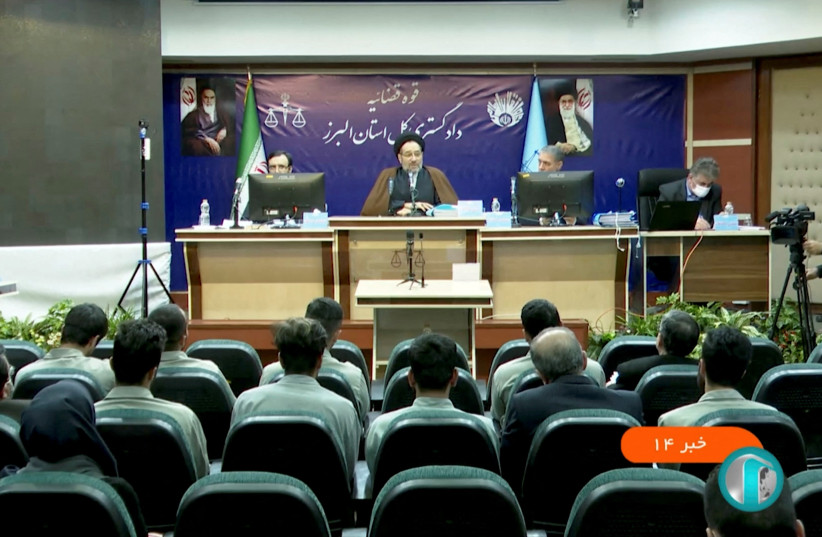Why is Iran pardoning protesters? - analysis

This decision by Iran’s supreme leader Ayatollah Ali Khamenei was announced on Sunday and was on the front page of pro-regime media.
Iran’s brutal regime, which recently was reported to sentence people to prison for a decade for dancing, has claimed to offer some kind of amnesty for people detained during the protests.
This decision by Iran’s supreme leader Ayatollah Ali Khamenei was announced on Sunday and was on the front page of pro-regime media. This means Iran is boasting about this not only to the West but also to its own people.
So what is Iran’s regime up to? This week, the IRGC was showing off by going up to northwestern Iran to check on some areas that had suffered under an earthquake.
Iran is projecting strength and wants to show that it is not worried by economic problems, an earthquake or even a recent drone attack on Isfahan. It wants to show it has weathered the storm and defeated the protests.
In September, Iran’s regime murdered Jina Amini, a Kurdish woman. The woman was accused of not wearing a head covering correctly.
In Iran, this can mean detention or murder by the regime’s far-right modesty policy. The Kurdish victim, a member of a national minority, was a natural victim of the regime, which expected that minorities will not be able to confront the regime or receive widespread backing.
The regime was wrong, and the murder of Amini led to huge protests for months. The international community, which had ignored past protests or even worked to appease the regime during the past protests, now was outraged.
However, almost a half year after the killing, the regime now feels more confident. The regime has now moved to make some amends for the last five months and wants to reduce tensions by claiming to give amnesty to a few.
So what is the regime doing? It has not given amnesty to “dual nationals” because it wants to maintain the fiction that it was “foreigners” responsible for the protests. In addition, the regime continues to slander Kurds and other minorities.
Iran’s pro-regime media such as Fars News and Tasnim included discussion of the amnesty on their homepages online. This is clearly a message that is all about showing off to Iran’s own people. This is about announcing something, whether or not it is true.
“According to the political coverage of Tasnim news agency, following the proposal of the head of the judiciary to Ayatollah Khamenei to agree to amnesty and reduce the punishment of a significant number of accused and convicted of recent events, as well as those convicted by public and revolutionary courts and the judicial organization of the armed forces, the leader of the Islamic Revolution said,” according to Tasnim.
Fars News basically said the same thing, noting that the supreme leader had decided to pardon and “reduce the punishment of a significant number of the accused and convicted of recent events.”
Divide-and-conquer
The reports said that those who had “committed wrong behaviors and crimes as a result of the incitement and propaganda of the enemy, which in addition to trouble for themselves, caused hardship to their families and relatives, and now a significant number of them are asking for forgiveness after the plan of foreign enemies and anti-revolutionary and anti-people currents were revealed.”
Therefore, amnesty is portrayed as helping those who were ignorant, naïve and deceived. Iran’s regime knows that a large number of people have seen the protests and detested the regime. The regime knows also that it cannot fight all the people all the time, it has to give amnesty to some, and fight some in the periphery, especially among the Baloch and Kurdish minorities. This is a kind of divide-and-conquer method that the regime has used since the 1980s.
The regime says it is not pardoning those who “committed espionage for the benefit of foreigners,” had contact with “foreign intelligence services” or harmed security forces. The point is to portray the “bad” protesters as those who were part of some foreign conspiracy and those who receive amnesty as part of the “good” part of Iran.
This is an intentional decision to divide the country and it is plausible that the amnesty will only be given to certain types of people in Iran. Basically, those closer to the center and elites, while minorities will continue to suffer.
The overall message of the regime is that it has won this round. It is giving amnesty because it is winning, at least in its own view. This does not come from a position of weakness or admitting the regime is wrong. This is happening after many months of crackdown where the regime now is no longer afraid and does not think the protests will increase. Clearly, this is why the regime is also willing to risk new sanctions this week and continue its close alliance with Russia. It believes the protests are largely over.
Jerusalem Post Store
`; document.getElementById("linkPremium").innerHTML = cont; var divWithLink = document.getElementById("premium-link"); if (divWithLink !== null && divWithLink !== 'undefined') { divWithLink.style.border = "solid 1px #cb0f3e"; divWithLink.style.textAlign = "center"; divWithLink.style.marginBottom = "15px"; divWithLink.style.marginTop = "15px"; divWithLink.style.width = "100%"; divWithLink.style.backgroundColor = "#122952"; divWithLink.style.color = "#ffffff"; divWithLink.style.lineHeight = "1.5"; } } (function (v, i) { });

